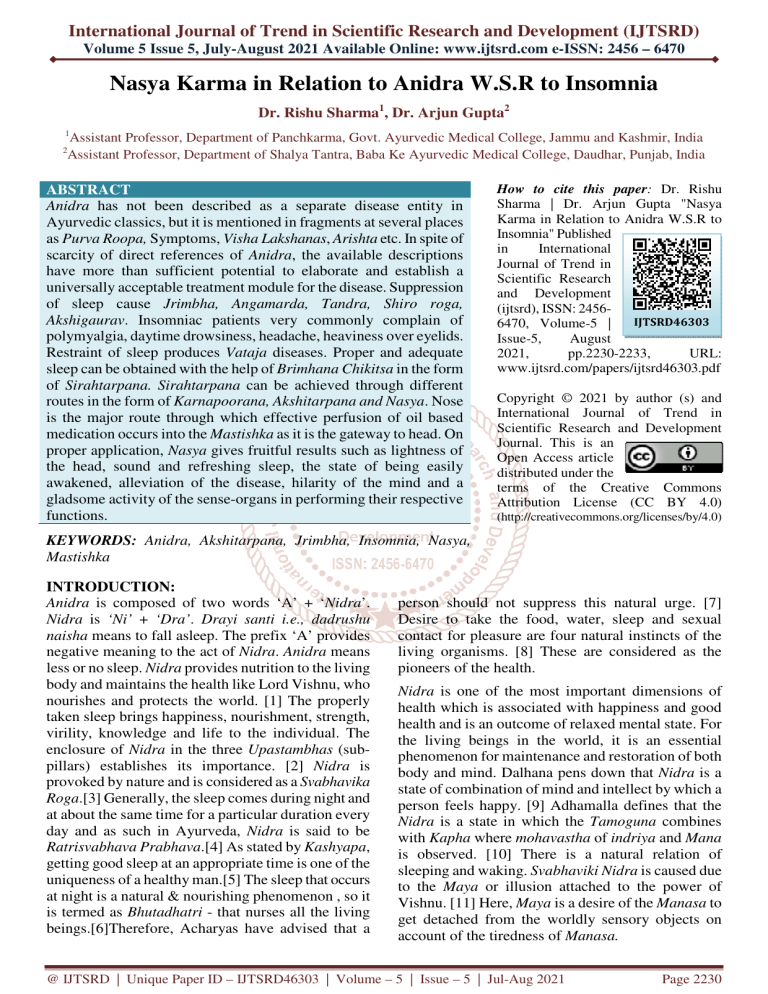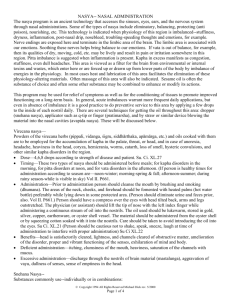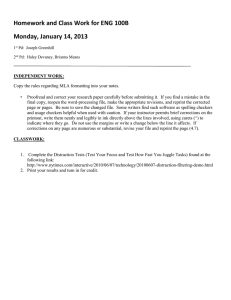
International Journal of Trend in Scientific Research and Development (IJTSRD) Volume 5 Issue 5, July-August 2021 Available Online: www.ijtsrd.com e-ISSN: 2456 – 6470 Nasya Karma in Relation to Anidra W.S.R to Insomnia Dr. Rishu Sharma1, Dr. Arjun Gupta2 1 2 Assistant Professor, Department of Panchkarma, Govt. Ayurvedic Medical College, Jammu and Kashmir, India Assistant Professor, Department of Shalya Tantra, Baba Ke Ayurvedic Medical College, Daudhar, Punjab, India ABSTRACT Anidra has not been described as a separate disease entity in Ayurvedic classics, but it is mentioned in fragments at several places as Purva Roopa, Symptoms, Visha Lakshanas, Arishta etc. In spite of scarcity of direct references of Anidra, the available descriptions have more than sufficient potential to elaborate and establish a universally acceptable treatment module for the disease. Suppression of sleep cause Jrimbha, Angamarda, Tandra, Shiro roga, Akshigaurav. Insomniac patients very commonly complain of polymyalgia, daytime drowsiness, headache, heaviness over eyelids. Restraint of sleep produces Vataja diseases. Proper and adequate sleep can be obtained with the help of Brimhana Chikitsa in the form of Sirahtarpana. Sirahtarpana can be achieved through different routes in the form of Karnapoorana, Akshitarpana and Nasya. Nose is the major route through which effective perfusion of oil based medication occurs into the Mastishka as it is the gateway to head. On proper application, Nasya gives fruitful results such as lightness of the head, sound and refreshing sleep, the state of being easily awakened, alleviation of the disease, hilarity of the mind and a gladsome activity of the sense-organs in performing their respective functions. How to cite this paper: Dr. Rishu Sharma | Dr. Arjun Gupta "Nasya Karma in Relation to Anidra W.S.R to Insomnia" Published in International Journal of Trend in Scientific Research and Development (ijtsrd), ISSN: 2456IJTSRD46303 6470, Volume-5 | Issue-5, August 2021, pp.2230-2233, URL: www.ijtsrd.com/papers/ijtsrd46303.pdf Copyright © 2021 by author (s) and International Journal of Trend in Scientific Research and Development Journal. This is an Open Access article distributed under the terms of the Creative Commons Attribution License (CC BY 4.0) (http://creativecommons.org/licenses/by/4.0) KEYWORDS: Anidra, Akshitarpana, Jrimbha, Insomnia, Nasya, Mastishka INTRODUCTION: Anidra is composed of two words ‘A’ + ‘Nidra’. Nidra is ‘Ni’ + ‘Dra’. Drayi santi i.e., dadrushu naisha means to fall asleep. The prefix ‘A’ provides negative meaning to the act of Nidra. Anidra means less or no sleep. Nidra provides nutrition to the living body and maintains the health like Lord Vishnu, who nourishes and protects the world. [1] The properly taken sleep brings happiness, nourishment, strength, virility, knowledge and life to the individual. The enclosure of Nidra in the three Upastambhas (subpillars) establishes its importance. [2] Nidra is provoked by nature and is considered as a Svabhavika Roga.[3] Generally, the sleep comes during night and at about the same time for a particular duration every day and as such in Ayurveda, Nidra is said to be Ratrisvabhava Prabhava.[4] As stated by Kashyapa, getting good sleep at an appropriate time is one of the uniqueness of a healthy man.[5] The sleep that occurs at night is a natural & nourishing phenomenon , so it is termed as Bhutadhatri - that nurses all the living beings.[6]Therefore, Acharyas have advised that a person should not suppress this natural urge. [7] Desire to take the food, water, sleep and sexual contact for pleasure are four natural instincts of the living organisms. [8] These are considered as the pioneers of the health. Nidra is one of the most important dimensions of health which is associated with happiness and good health and is an outcome of relaxed mental state. For the living beings in the world, it is an essential phenomenon for maintenance and restoration of both body and mind. Dalhana pens down that Nidra is a state of combination of mind and intellect by which a person feels happy. [9] Adhamalla defines that the Nidra is a state in which the Tamoguna combines with Kapha where mohavastha of indriya and Mana is observed. [10] There is a natural relation of sleeping and waking. Svabhaviki Nidra is caused due to the Maya or illusion attached to the power of Vishnu. [11] Here, Maya is a desire of the Manasa to get detached from the worldly sensory objects on account of the tiredness of Manasa. @ IJTSRD | Unique Paper ID – IJTSRD46303 | Volume – 5 | Issue – 5 | Jul-Aug 2021 Page 2230 International Journal of Trend in Scientific Research and Development @ www.ijtsrd.com eISSN: 2456-6470 Nose (Nasa) is considered to be that Gyanendriya, whose function is not only limited to respiration and olfaction, but it is also an important route for drug delivery. Nasya Karma is a therapeutic measure in which the drugs administered through nose eliminate vitiated Doshas situated in head and its constituent parts; thereby curing the disease of those parts. Nose is a pharmacological passage into the head. [12] When any type of irritation takes place in any part of the body, the local blood circulation is always increased. This occurs as a result of natural protective function of the body. Due to irritating effect of administered drugs, provocation of Doshas takes place in Shirah resulting in an increase in the blood circulation to brain. So extra accumulated morbid Doshas are expelled out from small blood vessels and ultimately these morbid Doshas are thrown out by the nasal discharge, tears and by salivation. From anatomical point of view, there are no such direct pharmacodynamics considerations between nose and cranial organs. Moreover, blood- brain -barrier is a strict security system that human brain has. The drugs are mostly believed to be absorbed through nasal and pharyngeal mucosa. It has been proved experimentally that the drug administered through nose shows effective action on the brain, supporting the fact that there is very close relation between Shirah and Nasa (nose). Therapy through intranasal administration has been an accepted form of treatment in the Ayurvedic system of Medicine. In recent years, many drugs have been shown to achieve better systemic bioavailability through nasal route as compared to oral administration. [13] Advances in biotechnology have made available a large number of protein and peptide drugs for the treatment of a variety of diseases. These drugs are unsuitable for oral administration because they are significantly degraded in the gastrointestinal tract or considerably metabolized by first pass effect in the liver. Even the parenteral route is inconvenient for long term therapy. Of many alternate routes approached, intranasal drug delivery is found much promising for administration of these drugs. [14] Nasally administered dosage forms generally deliver most of the drug to the ciliated region and, consequently, residence time is unlikely to be longer than a few minutes. [15] MATERIAL & METHODS: The matter in this manuscript is being written after thorough reading and analysis of Various Ayurvedic Textual books and commentaries. Relevant data has also been collected through some indexed medical journals. DISCUSSION & RESULTS: The sleep is an indicator of good health because it brings the normalcy in body tissue and relaxes the person. [16] Ayurveda’s approach towards the illness gives due consideration to both- psychic and somatic levels of body. According to Ayurveda, the emotional diseases should be cured by Gyanam, Vigyanam, Dhairya, Smriti and Samadhi. [17] When conventional medicine fails to treat insomnia efficaciously but rather produce adverse effects, patient seek Panchakarma therapies like Nasya karma. Probable Mode of Action of Nasya: The main doshas involved in Anidra are Vata and Pitta and according to Sushruta, Shiras is the sthana of all tridoshas. Hence, any medication which is mainly Vata and Pitta shamak has been effectively used for the study to provide satisfactory results. Each step of Purva karma, Pradhana karma and Paschat karma of Nasya karma has its own significance. In Purva karma, the Sthanika Abhyanga relieves tiredness and excess of Vata. Importance of Abhyanga has been described in classics by giving different examples. As the wheel of the cart, will run smoothly if regular oiling is done, in the same way the person who undergoes Abhyanga daily will not get affected by diseases. [18] That’s why oiling of the head is advised by Acharyas owing to its benefits of promoting sound sleep and happiness. [19] Swedana increases the local blood circulation and prepares the region for the drug absorption. [20] In Pradhana karma when the Nasya dravya are instilled into the nose by tilting of head enhance the drug entry into brain (stimulates olfactory neuron). Administration of oil in form of ‘Avichchhina dhara’ facilitates appropriate volume of drug to reach the desired site of action. [21] In Paschat karma the patient is advised to remain in a particular position, so that effective drug absorption occurs. This breaks down the pathogenesis of Anidra and results in “Sukhswapna’. When Nasya dravya is instilled into the nostril, the drug reaches Shringataka marma. According to Indu, its location is Shirosoantaramadhya. This marma is again in contact with siras of Nasa, Akshi, Karna and Gala. So, as the drug is instilled it will remain in upper part of nasal cavity and stimulates the olfactory neuron and thus the vitiated doshas are expelled out. [22] Even slight stimulation of Marma may have beneficial effect on the body, due to their connection with higher centers. Irritation of nasal mucosa through Nasya stimulates this area, by which the stability of mind occurs. This helps to locate the Mana in ‘Nirindriya Pradesha’ and patient may get sleep. [23] Olfactory nerve differs from the other @ IJTSRD | Unique Paper ID – IJTSRD46303 | Volume – 5 | Issue – 5 | Jul-Aug 2021 Page 2231 International Journal of Trend in Scientific Research and Development @ www.ijtsrd.com eISSN: 2456-6470 cranial nerves in its close relation with the brain where the sleep regulating centers are located. [24] It is also connected with the higher centers of brain like hypothalamus, limbic system. As the cilia are in direct contact with the source of smell and as the olfactory receptor cells connect directly with the brain, Nasya has a powerful and immediate effect on the body. Limbic system is concerned with behavioural aspect of human beings. [25] It mediates psychological functions by acting on limbic system through olfactory nerves. Tama when combines with Raja cause Vata Prakopa, which results in sleeplessness. Main cause of Anidra is Vata. Nasya is best treatment for Urdhvajatrugata Vata. Active principles of the drugs are penetrated through the mucosa due to adsorption effect and perfusion occurs to the brain cells which normalizes sleep. Nasal administration of medication helps to correct the disorders of Prana affecting the higher cerebral, sensory and motor functions. This may be the probable reason for reduction of frequent awakenings and sleep interruptions in the patients after Nasya therapy. According to Harita, the centre of sleep is in the upper half part of nose, between the two eyebrows in the cerebrum or brain. When the Tamas reaches this sleep center, the knowledge and activity get diminished and sleep occurs. Nasya has soothing effect on brain due to capillary perfusion. Hence stress is reduced and it helps in initiation of sleep. The drug administered through Nasya Karma is supposed to act on various neurotransmitter systems like opioid, serotonin and dopamine, which leads to reduction in negative emotions such as Krodha, Shoka, Bhaya etc. and also increase the positive emotions like Harsha, Preeti, Dhairya, etc. This action is related to its psychogenic response. CONCLUSION: Thus, Nasya Karma is an extremely effective Panchakarma intervention for patients of Anidra (Insomnia). The bioavailability of larger drug molecules through nasal mucosa can be improved by means of absorption enhancer or other approach. REFERENCES: [1] Maharishi Sushruta, Ayurveda Tattva Sandipika, Kaviraj Ambikadutta Shastri, Part I, Reprint 2011, Chaukhambha Sanskrit Sansthan, Sushruta Samhita, Sutra Sthana, Chapter-4, Verse No. -32, Page No. -44. [2] Agnivesha, Charaka Chandrika Hindi Commentary, Brahmanand Tripathi, Elaborated by Charaka and Dridhabala, Reprint 2004, Chaukhambha Surbharati Prakashan, Charaka Samhita, Sutra Sthana, Chapter 11, Verse No. 35, Page No. 238. [3] Maharishi Sushruta, Ayurveda Tattva Sandipika, Kaviraj Ambikadutta Shastri, Part I, Reprint 2011, Chaukhambha Sanskrit Sansthan, Sushruta Samhita, Sutra Sthana, Chapter-24, Verse No. -8, Page No. -131. [4] Agnivesha, Charaka Chandrika Hindi Commentary, Brahmanand Tripathi, Elaborated by Charaka and Dridhabala, Reprint 2004, Chaukhambha Surbharati Prakashan, Charaka Samhita, Sutra Sthana, Chapter 21, Verse No. 58, Page No. 410. [5] Sharma H. Kashyapa Samhita, Khilla, 5/7. 5th ed. Varanasi: Chaukhambha Sanskrit Sansthan; 1998, pg. 256. [6] Charaka Sutra 21/59 Agnivesha, Charaka Chandrika Hindi Commentary, Brahmanand Tripathi, Elaborated by Charaka and Dridhabala, Reprint 2004, Chaukhambha Surbharati Prakashan, Charaka Samhita, Sutra Sthana, Chapter 21, Verse No. 59, Page No. 410. [7] Agnivesha, Charaka Chandrika Hindi Commentary, Brahmanand Tripathi, Elaborated by Charaka and Dridhabala, Reprint 2004, Chaukhambha Surbharati Prakashan, Charaka Samhita, Sutra Sthana, Chapter 7, Verse No. 4, Page No. 163. [8] Vaidya Lakshmipati Shastri, Vidyotini Hindi Commentary, Edited by Bhisagratna Brahmashankara Shastri, Chaukhambha Prakashan, Reprint 2010, Yoga Ratnakar, Purvakhanda 64. [9] Yadavji T. Sushruta Samhita, Dalhana Nibandha Samgraha. Varanasi: Chaukhambha Surbharati, 1994. Sharira 1/25, pg 6. [10] Shastri P. Sharangdhara samhita. Varanasi: Krishnadas Academy; 2000. 6/24, pg. 74-75. [11] Maharishi Sushruta, Ayurveda Tattva Sandipika, Kaviraj Ambikadutta Shastri, Part I, Reprint 2011, Chaukhambha Sanskrit Sansthan, Sushruta Samhita, Sharira Sthana, Chapter-4, Verse No. -32, Page No. -44. [12] Agnivesha, Vidyotini Hindi Commentary, Sri Satya Narayana Shastri, Revised by Charaka and Dridhabala, Chaukhambha Bharati Academy, Reprint 2011, Charaka Samhita, Siddhi Sthana, Chapter 9, Verse No. 88, Page No. 1070. @ IJTSRD | Unique Paper ID – IJTSRD46303 | Volume – 5 | Issue – 5 | Jul-Aug 2021 Page 2232 International Journal of Trend in Scientific Research and Development @ www.ijtsrd.com eISSN: 2456-6470 [13] Y. W. Chein, K. S. E. Su and S. F. Chang. Nasal systemic drug delivery, Dekker, 1989, Page No. 1-77. [14] Beht et al ―Optimization of systemic nasal drug delivery with pharmaceutical excipients, Adv. Drug. Del. Rev, 1998, 29, 117-133 [20] A. T. Florence (1990), Routes of Drug Administration, Wright, Nasal drug delivery, Page No. 5 Anup Jain, A Textbook of Panchakarma, Jaypee Brothers Medical Publishers (P) Ltd. 2nd Edition, Chapter -7, Page No. -442. [21] Sarvesh Kumar Singh (2019), Panchakarma Parigyan – A Text Book on Panchakarma (Principles and Practices), First Edition, Chaukhambha Prakashan, Chapter-9, Page No. -585. [22] Principles and Practice of Panchakarma, Chaukhambha Publications, 2013, Chapter-14, Page No. - 563. [23] Dhamini Nirmal (2004), Role of Shirodhara with Indigenous Drugs in Manasa Bhavas of Anidra, IPGT &R, Jamnagar, Gujarat. [24] 24. The Cranial Nerves and Brainstem; Retrieved from https://myms.org/anatomy_brain_part4.htm [25] 25. V. Raj Mohan, the limbic system, Indian Journal of Psychiatry, 2007 Apr-Jun; 49(2): 132–139; Retrieved from https://www.ncbi.nlm.nih.gov/pmc/articles/PM C2917081. [15] [16] [17] [18] [19] Bhava Mishra, Commentary by Bulusu Sitaram, Forwarded by K. C. Chunekar, Chaukhambha Orientalia, Vol. -I, First Edition, 2006, Bhavaprakasha, Purva Khanda, Chapter 5, Verse No. -300, Page No- 95. Satya Pal Gupta, Psychopathology in Indian Medicine (With Special Reference to Its Philosophical Bases), Reprint 2000, Chaukhambha Sanskrit Pratishthan. Chapter10, Page No. 475. Vaidya Yadavji Trikamji Acharya edited Charaka samhita Sutra sthana, Chapter 5, shloka 85- 86, Edition Reprint 2008 Pub: Chaukhambha surbharati prakashan, K-37/117 Gopal Mandir lane post box No. 1129, Varanasi – 221001 Page No-115 Agnivesha, Charaka Chandrika Hindi Commentary, Brahmanand Tripathi, Elaborated by Charaka and Dridhabala, Reprint 2004, Chaukhambha Surbharati Prakashan, Charaka Samhita, Sutra Sthana, Chapter 5, Verse No. 81-83, Page No. -133. @ IJTSRD | Unique Paper ID – IJTSRD46303 | Volume – 5 | Issue – 5 | Jul-Aug 2021 Page 2233





